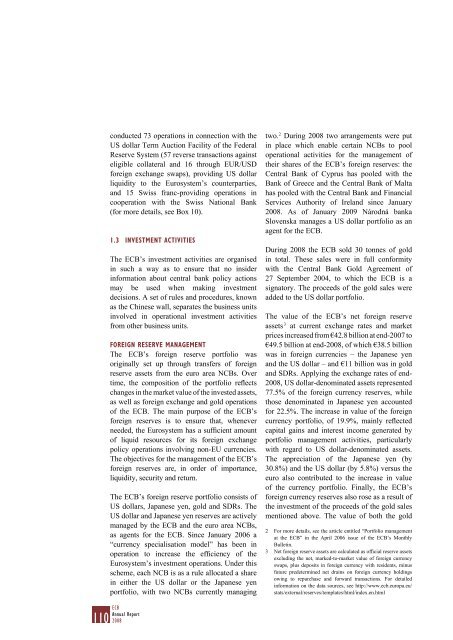ANNUAL REPORT 2008 - Polymer Bank Notes of the World
ANNUAL REPORT 2008 - Polymer Bank Notes of the World
ANNUAL REPORT 2008 - Polymer Bank Notes of the World
You also want an ePaper? Increase the reach of your titles
YUMPU automatically turns print PDFs into web optimized ePapers that Google loves.
conducted 73 operations in connection with <strong>the</strong>US dollar Term Auction Facility <strong>of</strong> <strong>the</strong> FederalReserve System (57 reverse transactions againsteligible collateral and 16 through EUR/USDforeign exchange swaps), providing US dollarliquidity to <strong>the</strong> Eurosystem’s counterparties,and 15 Swiss franc-providing operations incooperation with <strong>the</strong> Swiss National <strong>Bank</strong>(for more details, see Box 10).1.3 INVESTMENT ACTIVITIESThe ECB’s investment activities are organisedin such a way as to ensure that no insiderinformation about central bank policy actionsmay be used when making investmentdecisions. A set <strong>of</strong> rules and procedures, knownas <strong>the</strong> Chinese wall, separates <strong>the</strong> business unitsinvolved in operational investment activitiesfrom o<strong>the</strong>r business units.FOREIGN RESERVE MANAGEMENTThe ECB’s foreign reserve portfolio wasoriginally set up through transfers <strong>of</strong> foreignreserve assets from <strong>the</strong> euro area NCBs. Overtime, <strong>the</strong> composition <strong>of</strong> <strong>the</strong> portfolio reflectschanges in <strong>the</strong> market value <strong>of</strong> <strong>the</strong> invested assets,as well as foreign exchange and gold operations<strong>of</strong> <strong>the</strong> ECB. The main purpose <strong>of</strong> <strong>the</strong> ECB’sforeign reserves is to ensure that, wheneverneeded, <strong>the</strong> Eurosystem has a sufficient amount<strong>of</strong> liquid resources for its foreign exchangepolicy operations involving non-EU currencies.The objectives for <strong>the</strong> management <strong>of</strong> <strong>the</strong> ECB’sforeign reserves are, in order <strong>of</strong> importance,liquidity, security and return.The ECB’s foreign reserve portfolio consists <strong>of</strong>US dollars, Japanese yen, gold and SDRs. TheUS dollar and Japanese yen reserves are activelymanaged by <strong>the</strong> ECB and <strong>the</strong> euro area NCBs,as agents for <strong>the</strong> ECB. Since January 2006 a“currency specialisation model” has been inoperation to increase <strong>the</strong> efficiency <strong>of</strong> <strong>the</strong>Eurosystem’s investment operations. Under thisscheme, each NCB is as a rule allocated a sharein ei<strong>the</strong>r <strong>the</strong> US dollar or <strong>the</strong> Japanese yenportfolio, with two NCBs currently managingtwo. 2 During <strong>2008</strong> two arrangements were putin place which enable certain NCBs to pooloperational activities for <strong>the</strong> management <strong>of</strong><strong>the</strong>ir shares <strong>of</strong> <strong>the</strong> ECB’s foreign reserves: <strong>the</strong>Central <strong>Bank</strong> <strong>of</strong> Cyprus has pooled with <strong>the</strong><strong>Bank</strong> <strong>of</strong> Greece and <strong>the</strong> Central <strong>Bank</strong> <strong>of</strong> Maltahas pooled with <strong>the</strong> Central <strong>Bank</strong> and FinancialServices Authority <strong>of</strong> Ireland since January<strong>2008</strong>. As <strong>of</strong> January 2009 Národná bankaSlovenska manages a US dollar portfolio as anagent for <strong>the</strong> ECB.During <strong>2008</strong> <strong>the</strong> ECB sold 30 tonnes <strong>of</strong> goldin total. These sales were in full conformitywith <strong>the</strong> Central <strong>Bank</strong> Gold Agreement <strong>of</strong>27 September 2004, to which <strong>the</strong> ECB is asignatory. The proceeds <strong>of</strong> <strong>the</strong> gold sales wereadded to <strong>the</strong> US dollar portfolio.The value <strong>of</strong> <strong>the</strong> ECB’s net foreign reserveassets 3 at current exchange rates and marketprices increased from €42.8 billion at end-2007 to€49.5 billion at end-<strong>2008</strong>, <strong>of</strong> which €38.5 billionwas in foreign currencies – <strong>the</strong> Japanese yenand <strong>the</strong> US dollar – and €11 billion was in goldand SDRs. Applying <strong>the</strong> exchange rates <strong>of</strong> end-<strong>2008</strong>, US dollar-denominated assets represented77.5% <strong>of</strong> <strong>the</strong> foreign currency reserves, whilethose denominated in Japanese yen accountedfor 22.5%. The increase in value <strong>of</strong> <strong>the</strong> foreigncurrency portfolio, <strong>of</strong> 19.9%, mainly reflectedcapital gains and interest income generated byportfolio management activities, particularlywith regard to US dollar-denominated assets.The appreciation <strong>of</strong> <strong>the</strong> Japanese yen (by30.8%) and <strong>the</strong> US dollar (by 5.8%) versus <strong>the</strong>euro also contributed to <strong>the</strong> increase in value<strong>of</strong> <strong>the</strong> currency portfolio. Finally, <strong>the</strong> ECB’sforeign currency reserves also rose as a result <strong>of</strong><strong>the</strong> investment <strong>of</strong> <strong>the</strong> proceeds <strong>of</strong> <strong>the</strong> gold salesmentioned above. The value <strong>of</strong> both <strong>the</strong> gold2 For more details, see <strong>the</strong> article entitled “Portfolio managementat <strong>the</strong> ECB” in <strong>the</strong> April 2006 issue <strong>of</strong> <strong>the</strong> ECB’s MonthlyBulletin.3 Net foreign reserve assets are calculated as <strong>of</strong>ficial reserve assetsexcluding <strong>the</strong> net, marked-to-market value <strong>of</strong> foreign currencyswaps, plus deposits in foreign currency with residents, minusfuture predetermined net drains on foreign currency holdingsowing to repurchase and forward transactions. For detailedinformation on <strong>the</strong> data sources, see http://www.ecb.europa.eu/stats/external/reserves/templates/html/index.en.html110 ECBAnnual Report<strong>2008</strong>




![KNOW YOUR NEW GIBRALTAR BANKNOTES - [Home] bThe/b](https://img.yumpu.com/50890985/1/184x260/know-your-new-gibraltar-banknotes-home-bthe-b.jpg?quality=85)
![PAPUA NEW GUINEA - [Home] - Polymer Bank Notes of the World](https://img.yumpu.com/49758743/1/190x143/papua-new-guinea-home-polymer-bank-notes-of-the-world.jpg?quality=85)










